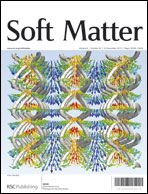Structure and dynamics of blood-clotting-inspired polymer-colloid composites
Abstract
Dynamic protein and cell aggregates form during the process of blood clotting, particularly in the initial stages where the crosslinks are physical. These aggregates are the scaffold for the final clot. Recently, it has been shown that such aggregates can be formed in the absence of cells, using silica colloids instead [H. Chen, M. A. Fallah, V. Huck, J. I. Angerer, A. J. Reininger, S. W. Schneider, M. F. Schneider and A. Alexander-Katz, Nat. Commun., 2013, 4, 1333]. Here we study the dynamics and structure of such aggregates using computer simulations. Our models are highly coarse-grained, and allow us to probe large length scales over long time scales. Here, we probe the system changing multiple aspects that contribute to the aggregation process, namely density of polymers and colloids, length of polymers, number of binding units per chain, shear rate, etc. In particular we find that the dynamics and structure of the polymers is dominated by the length of the polymers, as well as the number of binders per polymer. Interestingly the density does not have a large effect. Counter-intuitively, long polymers tend to form looser aggregates and sharply transform at higher rates to rather dense aggregates, while at lower rates the structure of the aggregates for the smaller polymers is much more compact. For all the different conditions, we find that they all behave qualitatively the same, yet there are some marked quantitative differences that can be exploited in real experiments. Our results complement recent studies on such aggregates and are important for understanding this newly discovered class of aggregates that could potentially have applications in multiple technologies.


 Please wait while we load your content...
Please wait while we load your content...